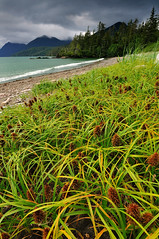In the coming weeks I hope to begin an experiment with grasses and sedges.
Lawns, Turf, grass, whatever you want to call it, I have found to be a necessity in a yard. I live on an acre of land but I have no lawn. When I had a lawn I spent much more time outside. But, being kind to the environment is important so I refuse to have a lawn of the typical water guzzling lawns st. augustine, bermuda, or any other common lawns.
Instead of watering everyday or every other day I hope to be watering ONCE A WEEK with the following lawns of
Carex Texensis: "Texas Sedge" Not a grass but a sedge (which superficially resemble grasses) This plant is actually Naturalized in California. It's not native, it's not invasive but it does well here.
Buchloe dactyloides: "Buffalo Grass" is an official grass and it is native to Texas, New Mexico, Northern Mexico, and Eastern Arizona. It seems like this would do well in regions with low water.
Zoysia Tenuifolia: "Korean Grass" is VERY beautiful when unmowed but not as practical as such. This grass is a little more common than the previous two but it is not commonly kept short or mowed. It is said to be drought tolerant, but we'll see how much so. (native obviously to Korea)
Because Astroturf contributes to the Urban Heat Island effect (a professor of mine measure the temperature of synthetic turf on a 55 F degree day and it read at 110F) I will not be using that stuff.
I plan to log the cost of each plant, the frequency of trimming, the rate of spreading and the water usage and compare it to a typical lawn. Who knows how long it will take and whether they'll like the area I plant them in. Which reminds me. I would like to plant them in front of the Commons at the Center for Regenerative Studies (where I work and go to school). There is an unused plot because we cannot grow food products there due to contamination. It would be perfect and because the plot is unused is why I came up with the idea. All i have to do is ask my boss. Let's hope Juan says yes.
Wednesday, August 27, 2008
Subscribe to:
Post Comments (Atom)





3 comments:
Anduhrew, Sounds like a good comparison. I would offer an alternative. Almost all synthetic turf companies utilize a black crumb rubber or rubber and sand mixed infill and the combination of the black infill with the "plastic" fibers does create a heat island effect. Our company does not use any rubber for our fields. We use Organite (Anti-Microbial Infill)which not only is a tan/sand color, but also retains up to 240% of it's original body wieght in moisture, which results in a cooling effect. Our open sports fields can be about 20 degrees cooler than others. The fact that an AMI kills bio-related microbial infectious disease is a plus, but as the installers of the most environmentally sound synthetic turf systems, we think of ourselves as "Greener Than Grass". Keep in mind, too, that we all like grass more, but in extreme areas (such as high-use venues and areas where we have to choose between drinking water and green grass)turf is a good answer. Should you like to include a sample of our system in the study, please let me know. Thanks, Duncan
Duncan, I think that's a good idea, But for this specific project i won't have the space, and I think i'd have to come up with a different study. So in future studies I will definitely look into your company's product.
Gare, I will not join the move for weather control, I think the natural system shouldn't be screwed with too much. but thanks for the spam anyways.
This was greeat to read
Post a Comment